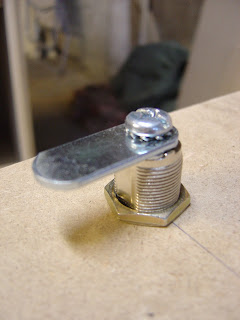For starters I installed the board between control panel (CP) and bezel. I made the small panel little wider so I could actually screw it from the outside of the cabinet without splitting it. And making the piece wider also allowed me to install the CP support pieces. I have an order delivery coming up which contains a set of reproduction Nintendo CP clamps. With that I can lock the control panel tight in place. The CP board itself has a slight angle of about 15 degrees on the bezel side, because the panel is mounted under that angle. So it al fits nicely with no gaps.
I taped the bezel in place just to see where i wanted to monitor to be, considering all the artwork alongside the bezel. If you look carefully, there's this cardboard box on the background. I measured the Hantarex monitor case and carefully duct-taped this cardboard 'monitor' together.
This way I could easily move and try out different mounting positions without having to tow the 30 kilograms heavy screen around.




About the same time, I recieved my coin door complete with mechs which I had bought on Ebay. It is a used one, made in 1988. Nice feature, it has a coin counter as well, with 33.000-something plays on it :).
Unfortunatly it is not an original Donkey Kong coin door, but it'll do just fine. I was bidding on an original Nintendo coin door some time ago. It sold for 65 dollars. Considering this over-/under door was only 30, its not a bad buy. After I took the pictures, I disassembled it, straightend a couple of dented spots and cleaned it up real good with water and soap but i'll repaint it anyway. I don't especially like the Hammerite finish. I would rather paint it just black, more like the Nintendo one.



The coin mechanisms themselves work perfectly fine. Though it took me a day or two to get a hold of American quarters to test it :) As show on the image above, taken from the coinbox, there are two screws which you can adjust to modify the mech so it accepts different types of coins. One screw for the width and on the other side of the mech a screw for the height of the coin. But the plastic screw that is in my mech didn't age very well, it is very brittle so I'd rather leave this one on US quarters.
Though I allready orderd some new mechs which I can alter as well. So once I recieve them I'd probably set them up to accept 50 eurocent coins. They are a little easier to come-by on this side of the ocean.
Next up was installing a strong platform for the heavy 30 kilo monitor. So I cut out a piece of MDF the size of my monitor bottom, screwed and glued to two big wooden beams underneath and installed that inside the cabinet. Af first I wanted a more genuine Nintendo cabinet structure concerning the monitor support (metal bar on top or metal L-pieces on both sides of the monitor), but this was more easy and should do the job. It's not completely done yet, still have to fit a beam for the backside of the monitor to keep the thing in place, but I was out of wood.
When that's done I will fit some brackets into the sides of the monitor and onto the platform so the screen can't go anywhere when moving.




It might look awkward, the 45 degree angle at which the support platform is mounted, but in fact this is the original style and I really love how steep it is. Can't wait to see Street Fighter 3: third Strike in action! Keep practicing John!
About the monitor mounting, at first I really wanted to strip the monitor out of it's case and have it supported by a metal bar like the original Donkey Kong. But after decasing the thing I noticed there are no bolt holes on the corners of the tube! It is just clamped by small metal triangles on the corners, which themselves can be bolted in the metal case. So leaving it in the case is the only option, and the easiest one too.
Not to mention I had to cut a small 15 centimeters of the top-backside of the monitor case for it to even FIT in the Donkey Kong cabinet :).







































































